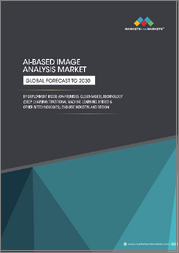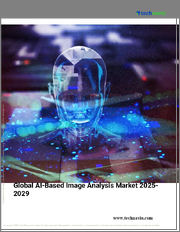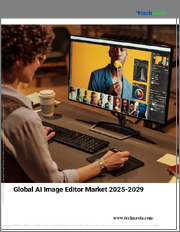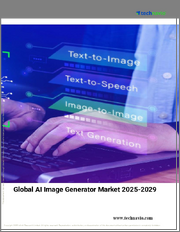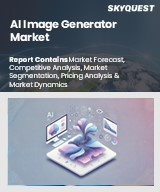
|
시장보고서
상품코드
1856764
AI 영상 인식 시장 : 컴포넌트, 테크놀러지, 애플리케이션, 최종사용자 산업, 배포 모드별 - 세계 예측(2025-2032년)AI Image Recognition Market by Component, Technology, Application, End User Industry, Deployment Mode - Global Forecast 2025-2032 |
||||||
AI 영상 인식 시장은 2032년까지 CAGR 11.17%로 577억 달러로 성장할 것으로 예측됩니다.
| 주요 시장 통계 | |
|---|---|
| 기준연도 2024 | 247억 2,000만 달러 |
| 추정연도 2025 | 273억 3,000만 달러 |
| 예측연도 2032 | 577억 달러 |
| CAGR(%) | 11.17% |
경영 의사결정권자를 위해 기술적 역량, 거버넌스 우선순위, 업무상 트레이드오프를 명확히 하는 AI 이미지 인식의 전략적 방향성
첨단 컴퓨터 비전 능력의 출현은 조직이 시각적 데이터를 의사결정을 위한 핵심 입력으로 인식하는 방식을 재구성했습니다. 각 산업 분야에서 개선된 센서, 더 강력한 프로세서, 정교한 알고리즘을 통해 이미지 인식은 연구 호기심에서 실용적인 비즈니스 능력으로 승화되었습니다. 경영진은 현재 데이터 거버넌스, 모델 설명 가능성, 통합의 복잡성을 관리하면서 기술 투자를 비즈니스 우선순위에 맞게 조정해야 하는 과제에 직면해 있습니다.
실제로 기업은 자체 개발 및 타사 솔루션의 절충점을 탐색하고, 신속한 배포의 장점과 맞춤형 정확도 및 개인 정보 보호 관리의 필요성을 저울질하고 있습니다. 전략적 구매자는 기술적 성능뿐만 아니라 모델 유지보수, 데이터세트 큐레이션, 지속적인 재교육과 관련된 수명주기 비용도 고려해야 합니다. 규제 당국의 감시가 강화되고 최종사용자가 더 높은 투명성을 요구함에 따라 리더은 신뢰와 컴플라이언스를 유지하기 위해 설명 가능한 파이프라인과 견고한 검증 프레임워크를 우선순위에 두고 있습니다.
이 소개에서는 실용적인 도입 시나리오와 진화하는 기술 역량이 어떻게 교차하는지에 초점을 맞춘 이그제큐티브 신세션의 무대를 마련합니다. 또한 부문 간 거버넌스, 반복적인 개선을 용이하게 하는 모듈식 아키텍처, 이미지 인식에 대한 투자를 측정 가능한 비즈니스 가치로 직결시키는 성과 우선주의 사고방식의 중요성을 강조하고 있습니다.
모델 아키텍처의 진화, 센서의 발전, 하이브리드 배포 전략이 이미지 인식의 운영 도입과 윤리적 거버넌스를 재구성
이미지 인식을 둘러싼 환경은 모델 아키텍처, 센서 기술, 도입 패러다임의 발전에 힘입어 일련의 변화의 시기를 맞이하고 있습니다. 최신 딥러닝 접근법은 다양한 환경 조건에서 더 높은 정확도를 지원하도록 성숙해졌으며, 새로운 센서 설계는 데이터 충실도를 향상시키고 에지 배포 비용을 낮추고 있습니다. 이러한 기술적 변화는 지연시간, 대역폭, 프라이버시 제약으로 인해 이전에는 실용적이지 못했던 새로운 이용 사례를 가능하게 하고 있습니다.
동시에 모놀리식 클라우드 전용 솔루션에서 엣지 디바이스와 중앙 집중식 플랫폼에 추론을 분산시키는 하이브리드 모델로 전환하고 있습니다. 이러한 하이브리드화는 운영 대기 시간을 단축하고 프라이버시를 보호하는 아키텍처를 지원하는 반면, 오케스트레이션과 모델 동기화에서 새로운 복잡성을 야기합니다. 또 다른 중요한 변화는 이미지 데이터를 텍스트, 음성, 센서 텔레메트리와 결합하여 보다 풍부한 맥락 이해와 보다 견고한 의사결정을 위한 멀티모달 퓨전(multimodal fusion)에 대한 관심이 높아지고 있다는 점입니다.
조직적으로, 기업은 파일럿 중심의 노력에서 부서 간 거버넌스, 표준화된 테스트 프로토콜, 지속적인 성능 모니터링이 필요한 대규모 프로그램으로 전환하고 있습니다. 기술 프로바이더, 표준화 단체, 업계 컨소시엄 간의 파트너십은 상호운용성과 윤리적 프레임워크를 가속화하고 있습니다. 이러한 변화를 종합하면 전략적 채용이 운영 준비와 장기적인 모델 성능을 유지할 수 있는 능력에 의해 지배되는 이 분야의 성숙을 시사합니다.
미국의 관세 정책 변화가 이미지 인식 구상의 조달 전략, 배포 아키텍처, 공급망 강인성에 미치는 영향
최근 무역 정책 동향, 특히 미국의 관세 조정으로 인해 수입 하드웨어 및 통합 턴키 시스템에 의존하는 조직은 조달 및 공급망 계획에 대한 새로운 고려 사항이 도입되었습니다. 관세 변화는 카메라, 프로세서, 특수 센서를 해외 벤더로부터 조달하는 경우와 국내 제조 파트너십 및 재고 버퍼링에 투자하는 경우의 상대적 경제성에 영향을 미칠 수 있습니다. 조달팀은 공급업체와의 계약을 재검토하고, 대체 벤더를 조속히 인증하고, 투입 비용의 변동성을 완화하기 위해 계약 헤지를 검토하는 등 대응하고 있습니다.
동시에 관세는 배포 아키텍처 선택에도 영향을 미칩니다. 기업은 관세로 인한 하드웨어 비용 상승의 영향을 줄이기 위해 하드웨어에 구애받지 않는 소프트웨어 중심 솔루션을 선호할 수도 있고, 시스템을 완전히 교체하지 않고도 단계적으로 업그레이드할 수 있는 모듈식 하드웨어 설계를 평가할 수도 있습니다. 수 있습니다. 이러한 전략은 장기적인 유연성을 유지하고 자본의 고정화를 줄일 수 있습니다. 규제와 보안 요구사항이 까다로운 업계의 최종사용자들은 국경 간 정책 변화에 노출될 위험을 줄이기 위해 On-Premise 도입과 현지 생산의 이점을 점점 더 중요하게 여기고 있습니다.
이와 병행하여, 조달 전략에서는 BOM과 물류 일정에 대한 가시성을 높이기 위해 공급업체와의 긴밀한 협력이 중요시되고 있습니다. 기업은 관세 변경이 총소유비용과 배치 순서에 미치는 다운스트림 영향을 모델링하기 위해 시나리오 계획 및 고급 조달 분석에 투자하고 있습니다. 결국 무역정책에 대한 고려는 조달의 주변적 관심사에서 기술 전략과 아키텍처 의사결정의 중심 요소로 이동하고 있습니다.
상세한 세분화 분석을 통해 컴포넌트, 기술, 용도, 산업, 배치 선택이 전략적 기회와 제약조건을 어떻게 결정하는지 파악할 수 있습니다.
미묘한 세분화 프레임워크는 컴포넌트, 기술, 용도, 산업, 도입 형태에서 가치가 창출되는 곳과 도입 마찰이 발생하는 곳을 명확히 합니다. 컴포넌트별로 분석하면, 비즈니스 기회는 하드웨어, 서비스, 소프트웨어에 분산되어 있으며, 하드웨어 수요는 고해상도 캡처와 빠른 엣지 추론을 가능하게 하는 카메라, 프로세서, 센서가 주도하고, 서비스는 컨설팅 서비스, 구축, 배포 서비스, 프로토타입을 양산 시스템으로 전환하는 통합 서비스를 중심으로, 소프트웨어는 분석 툴, 이미지 처리 소프트웨어, 특징 추출 및 추론 파이프라인에 초점을 맞춘 머신러닝 알고리즘에 이르기까지 다양합니다.
기술이라는 렌즈를 통해 보면, 코드 인식, 얼굴 인식, 물체 인식, 광학 문자 인식, 패턴 인식은 각각 솔루션 설계를 형성하는 정확도, 프라이버시, 대기시간의 트레이드오프를 명확하게 보여줍니다. 증강현실과 이미지 검색은 낮은 레이턴시 임베딩과 강력한 컨텍스트 매칭을 필요로 하고, 마케팅 및 광고는 개인화 및 어트리뷰션 메트릭스를 우선시하며, 스캔과 이미지 처리는 고충실도 캡처와 전처리가 필요하고, 보안 및 모니터링은 오감지 관리와 규제에 중점을 둡니다. 감지 관리 및 규제 준수에 중점을 둡니다.
산업별 채용은 수직적 요구에 따라 달라집니다. 자동차 분야에서는 실시간 사물 인식 및 센서 융합, 은행 및 금융 서비스 분야에서는 안전한 신원 확인 및 문서 OCR, 엔터테인먼트 및 미디어 분야에서는 이미지 검색 및 컨텐츠 태깅, 헬스케어 분야에서는 영상 진단 및 이상 징후 감지, 제조 및 유통 분야에서는 개인화된 추천 및 손실 방지, 소매업에서는 시각적 검사 및 프로세스 최적화, 그리고 제조 분야에서는 시각적 검사 및 프로세스 최적화, 소매업에서는 개인화된 추천 및 손실 방지에 중점을 두고 있습니다. 마지막으로 클라우드 기반 또는 On-Premise 도입 형태는 확장성 및 관리형 서비스와 프라이버시, 지연, 규제적 제약과 균형을 맞추는 전략적 축으로, 통합 접근 방식과 벤더 선택 기준을 형성하고 있습니다.
아메리카, 유럽, 중동/아프리카, 아시아태평양에서의 전개 전략과 상업적 접근 방식을 형성하는 지역적 역학 및 규제 환경
지역적 역학은 이미지 인식 구상의 기술 전략, 조달 및 규제 준수를 결정하는 중요한 요소입니다. 미국 대륙에서는 혁신 클러스터와 강력한 벤처 활동이 소비자 용도과 기업 분석에서 채택을 가속화하는 반면, 지역 데이터 보호 프레임워크와 주정부 차원의 규제는 신중한 프라이버시 엔지니어링과 현지화 전략을 필요로 합니다. 이 지역의 기업은 클라우드의 확장성과 지연시간 및 컴플라이언스 요구사항을 충족하는 엣지 처리 기능의 균형을 맞추기 위해 하이브리드 도입을 자주 채택하고 있습니다.
유럽, 중동 및 아프리카에서는 규제 감시와 다양한 시장 구조가 이미지 인식 솔루션 도입 방식에 영향을 미치고 있습니다. 보다 엄격한 프라이버시 프레임워크와 국경 간 데이터 전송을 고려할 때, On-Premise 또는 현지화된 클라우드 배포이 선호되는 경우가 많으며, 지역 관계자가 추진하는 상호운용성 표준이 조달 기준을 형성하고 있습니다. 그럼에도 불구하고 공공과 민간 모두에서 수요가 많은 분야에서는 모니터링, 헬스케어, 산업 자동화를 위한 안전하고 감사 가능한 파이프라인에 대한 투자가 활발히 이루어지고 있습니다.
아시아태평양은 빠른 디지털 전환, 고밀도 도시화, 강력한 제조 인프라로 인해 엣지 최적화 하드웨어와 확장 가능한 소프트웨어 플랫폼에 대한 수요가 급증하고 있습니다. 이 지역의 채택 패턴은 스마트 제조, 소매 자동화, 운송 시스템 등 고처리량 이용 사례에 중점을 두는 경향이 있으며, 지연 시간을 줄이고 각 국가의 데이터 거버넌스 우선순위에 따라 현지화된 모델과 파트너십에 대한 관심이 높아지고 있습니다. 이러한 지역적 차이를 이해하면, 필요에 맞는 시장 진입 접근 방식과 리스크를 고려한 전개 계획을 세울 수 있습니다.
경쟁 환경 인사이트: 차별화된 기술 스택, 전략적 파트너십, 특화된 제품이 어떻게 방어 가능한 포지션과 배포 우위를 창출할 수 있는지를 보여줍니다.
이미지 인식 분야의 경쟁 세력은 기존 기술 벤더, 전문 하드웨어 공급업체, 도메인 특화 모델 및 배포 서비스를 제공하는 민첩한 스타트업이 혼재되어 있는 것이 특징입니다. 시장을 선도하는 기업은 기술 깊이, 강력한 데이터세트, 통합 플랫폼으로 차별화를 꾀하고 기업 고객의 Time-to-Value를 단축하고 있습니다. 동시에, 전문 프로바이더는 특정 정확도 및 규정 준수 요구 사항을 충족하는 수직적 이용 사례와 구성 가능한 모델에 집중함으로써 내구성이 뛰어난 틈새 시장을 개발합니다.
시스템 통합사업자와 매니지드 서비스 프로바이더가 모델 개발과 운영 배포의 간극을 메우면서 파트너십과 제휴가 구현을 확대하는 중심이 되고 있습니다. 이러한 제휴를 통해 데이터 주석, 모델 검증, 장기 모니터링을 포함한 번들 제공이 용이해집니다. 투자 활동에서는 엔드 투 엔드 솔루션을 제공할 수 있는 기업이나 신속한 엣지 구축이 가능한 기업이 선호되고 있으며, 이는 사내 운영 오버헤드를 최소화하는 턴키 경험에 대한 구매자의 선호를 반영하고 있습니다.
컴퓨터 비전, 데이터 엔지니어링, MLOps에 능통한 엔지니어 확보 경쟁이 치열해지면서 인재 확보와 확보가 차별화 요소로 작용하고 있습니다. 강력한 도메인 지식과 엄격한 검증 프레임워크로 기술력을 보완하는 기업은 고객으로부터 신뢰도를 높일 수 있습니다. 한편, 개발자 생태계를 위한 개방성과 모델 아키텍처 및 교육 파이프라인의 고유한 우위성을 균형 있게 유지하는 지적재산권 전략은 지속가능한 경쟁력을 지원합니다.
경영진이 채택을 가속화하고, 위험을 줄이며, 지속가능한 이미지 인식 역량을 구축하기 위해 실행 가능한 전략적 및 업무적 권장 사항을 제시
업계 리더은 단기적인 승리와 장기적인 역량 구축을 일치시키는 현실적인 포트폴리오 접근 방식을 우선시해야 합니다. 먼저, 이미지 인식이 측정 가능한 업무 개선과 위험 감소를 가져올 수 있는 영향력 있는 이용 사례를 식별하고, 명확한 성공 지표와 현실적인 범위로 파일럿 프로그램을 구성합니다. 동시에 센싱, 추론, 오케스트레이션의 각 레이어를 분리한 모듈형 아키텍처에 투자하여 단계적 업그레이드와 벤더의 유연성을 확보할 수 있도록 합니다.
운영 측면에서는 시스템의 신뢰성과 감사 가능성을 보장하기 위해 데이터 검증, 모델 검증, 성능 모니터링에 대한 견고한 거버넌스를 도입합니다. 또한 프라이버시 바이 디자인 원칙을 채택하고 이해관계자와 규제 당국의 기대에 부응하기 위해 추론 파이프라인에 통합할 수 있는 설명가능성 툴을 평가하는 것도 필수적입니다. 조달 측면에서는 투명한 수명주기 비용과 지속적인 모델 유지보수 및 데이터세트 관리를 위한 서비스 수준 계약을 제공하는 솔루션을 우선적으로 고려합니다.
마지막으로 기술적 성과를 비즈니스 가치로 전환하기 위해 도메인 전문가, 데이터 사이언티스트, 오퍼레이션 리드를 모아 교차 기능 팀을 육성합니다. 중요한 지적 재산의 관리를 유지하면서 역량 격차를 해소하기 위해 스킬업 프로그램 및 전략적 파트너십에 투자합니다. 이러한 권장 사항을 실행함으로써 기업은 리스크를 관리하면서 도입을 가속화하고, 기술 및 규제 환경의 변화에 따라 유연하게 대응할 수 있습니다.
전문가 인터뷰, 기술 검토, 워크샵, 분석적 검증을 통합한 엄격한 혼합 방법론별 조사 접근 방식을 통해 실용적이고 신뢰할 수 있는 인사이트를 보장
조사방법은 엄밀성과 실용적 타당성을 확보하기 위해 여러 가지 정성적 방법과 정량적 방법을 결합했습니다. 1차 조사는 기술 리더, 시스템 통합사업자, 제품 관리자 및 각 분야의 전문가들과의 구조화된 인터뷰를 통해 도입 과제, 벤더 선택 기준 및 운영 우선순위에 대한 생생한 관점을 파악했습니다. 이 인터뷰는 가설 생성에 참고가 되었고, 현실 세계의 구현 제약에 대한 배경을 제공했습니다.
2차 조사에서는 기술 문헌, 특허 출원, 공식 문서, 규제 지침, 벤더의 백서를 체계적으로 검토하여 기술 궤적을 매핑하고 솔루션 설계에서 반복적으로 나타나는 패턴을 파악했습니다. 또한 지연시간, 프라이버시, 확장성에 대한 가정을 스트레스 테스트하기 위한 시나리오 기반 연습을 통해 실무자와의 워크숍을 통해 인사이트를 검증했습니다. 질적 입력과 관찰된 제품 로드맵 및 도입 사례를 상호 참조하여 증거의 삼각측정을 수행했습니다.
분석 방법으로는 아키텍처 간 기능적 트레이드오프를 평가하는 역량 매핑, 규제 및 공급망에 미치는 영향을 평가하는 리스크 분석, 파일럿 단계의 구상과 프로덕션 배포를 구분하기 위한 성숙도 점수화 등이 포함되었습니다. 데이터의 무결성은 반복적인 검증을 통해 유지되며, 조사 결과는 기술 및 조달 리더이 조사에서 얻은 인사이트를 운영 프로그램에 반영할 수 있는 실행 가능한 지침으로 통합되었습니다.
이미지 인식 능력을 지속가능한 기업 가치로 전환하는 데 필요한 운영 전제조건, 거버넌스 규율, 전략적 초점을 강조하는 결론적 통합
향상된 센싱 하드웨어, 첨단 기계학습 아키텍처, 유연한 배포 모델의 결합으로 이미지 인식은 보다 풍부한 상황 인식과 자동화를 추구하는 조직에 있으며, 기본 역량으로 자리매김하고 있습니다. 기술 발전으로 진입장벽은 낮아졌지만, 지속가능한 가치의 실현은 신중한 아키텍처 선택, 거버넌스 구조, 비즈니스 목표와의 긴밀한 연계에 달려있습니다. 모듈화된 시스템, 강력한 검증, 부서 간 팀에 투자하는 조직은 역량을 임팩트로 전환할 수 있는 가장 좋은 위치에 있습니다.
무역 정책 및 지역 규제 역학은 조달 및 아키텍처 결정에 영향을 미치는 복잡한 계층을 추가하여 시나리오 계획 및 공급업체 다각화를 탄력적 전략의 필수 구성 요소로 만듭니다. 경쟁 우위는 각 분야의 전문성과 확장 가능한 MLOps 관행을 통합하고, 모델의 정확성, 감사 가능성, 이해관계자의 기대에 대한 일관성을 장기적으로 유지할 수 있는 기업에게 주어집니다.
마지막으로 이미지 인식은 산업 전반에 걸쳐 구체적인 기회를 제공하지만, 그 기회를 실현하기 위해서는 기술적 엄격함, 운영상의 규율, 전략적 선견지명이 의도적으로 조화를 이루어야 합니다. 빠른 실험과 견고한 거버넌스의 균형을 유지하는 리더는 대규모 도입에 따른 리스크를 줄이면서 지속적인 우위를 창출할 수 있습니다.
목차
제1장 서문
제2장 조사 방법
제3장 개요
제4장 시장 개요
제5장 시장 인사이트
제6장 미국 관세의 누적 영향 2025
제7장 AI의 누적 영향 2025
제8장 AI 영상 인식 시장 : 컴포넌트별
- 하드웨어
- 카메라
- 프로세서
- 센서
- 서비스
- 컨설팅 서비스
- 배포 서비스
- 통합 서비스
- 소프트웨어
- 분석 툴
- 영상 처리 소프트웨어
- 기계학습 알고리즘
제9장 AI 영상 인식 시장 : 기술별
- 코드 인식
- 얼굴 인식
- 물체 인식
- 광학식 문자 인식
- 패턴 인식
제10장 AI 영상 인식 시장 : 용도별
- 증강현실
- 영상 검색
- 마케팅 & 광고
- 스캐닝 & 이미징
- 보안·감시
제11장 AI 영상 인식 시장 : 최종사용자 산업별
- 자동차
- 은행, 금융 서비스&보험
- 엔터테인먼트 & 미디어
- 헬스케어
- 제조업
- 소매
제12장 AI 영상 인식 시장 : 배포 모드별
- 클라우드 기반
- 온프레미스
제13장 AI 영상 인식 시장 : 지역별
- 아메리카
- 북미
- 라틴아메리카
- 유럽, 중동 및 아프리카
- 유럽
- 중동
- 아프리카
- 아시아태평양
제14장 AI 영상 인식 시장 : 그룹별
- ASEAN
- GCC
- EU
- BRICS
- G7
- NATO
제15장 AI 영상 인식 시장 : 국가별
- 미국
- 캐나다
- 멕시코
- 브라질
- 영국
- 독일
- 프랑스
- 러시아
- 이탈리아
- 스페인
- 중국
- 인도
- 일본
- 호주
- 한국
제16장 경쟁 구도
- 시장 점유율 분석, 2024
- FPNV 포지셔닝 매트릭스, 2024
- 경쟁사 분석
- Airy3D Inc.
- Amazon Web Services, Inc.
- Anthropic PBC
- Blippar Group Limited
- Clarifai, Inc.
- Cognitec Systems
- DataRobot, Inc.
- Delaware corporation
- Fritz Labs Inc.
- Google LLC by Alphabet Inc.
- Honeywell International Inc.
- Huawei Cloud Computing Technologies Co., Ltd.
- Infrrd Inc.
- Intel Corporation
- International Business Machines Corporation
- iProov Ltd
- MERCURIO PLATFORM, S.L.
- Microsoft Corporation
- Monolith AI Ltd.
- NEC Corporation
- Nvidia Corporation
- Oracle Corporation
- Panasonic Holdings Co., Ltd.
- Qualcomm Technologies, Inc.
- Snap2Insight Inc.
- Standard Cognition, Corp
- Toshiba Corporation
- Trax Technology Solutions Pte Ltd.
- Vispera Information Technologies
- Ximilar s.r.o.
The AI Image Recognition Market is projected to grow by USD 57.70 billion at a CAGR of 11.17% by 2032.
| KEY MARKET STATISTICS | |
|---|---|
| Base Year [2024] | USD 24.72 billion |
| Estimated Year [2025] | USD 27.33 billion |
| Forecast Year [2032] | USD 57.70 billion |
| CAGR (%) | 11.17% |
A strategic orientation to AI image recognition that frames technological capabilities, governance priorities, and operational trade-offs for executive decision-makers
The emergence of advanced computer vision capabilities has reshaped how organizations perceive visual data as a core input for decision-making. Across industries, improved sensors, more powerful processors, and refined algorithms have elevated image recognition from a research curiosity into a pragmatic business capability. Executives now face the challenge of aligning technology investments with operational priorities while managing data governance, model explainability, and integration complexity.
In practice, organizations are navigating trade-offs between in-house development and third-party solutions, weighing the benefits of rapid deployment against the need for tailored accuracy and privacy controls. Strategic buyers must consider not only technological performance but also lifecycle costs associated with model maintenance, dataset curation, and continuous retraining. As regulatory scrutiny increases and end users demand greater transparency, leaders are prioritizing explainable pipelines and robust validation frameworks to maintain trust and compliance.
This introduction sets the stage for a focused executive synthesis that highlights how practical adoption scenarios intersect with evolving technical capabilities. It emphasizes the importance of cross-functional governance, a modular architecture that facilitates iterative improvements, and an outcomes-first mindset that ties image recognition investments directly to measurable business value.
The evolution of model architectures, sensor advances, and hybrid deployment strategies that are reshaping operational adoption and ethical governance in image recognition
The landscape of image recognition is undergoing a sequence of transformative shifts driven by advancements in model architectures, sensor technology, and deployment paradigms. Modern deep learning approaches have matured to support higher accuracy across diverse environmental conditions, while novel sensor designs improve data fidelity and lower the cost of edge deployments. These technological shifts are enabling new use cases that were previously impractical due to latency, bandwidth, or privacy constraints.
Concurrently, there is a progressive shift from monolithic, cloud-only solutions toward hybrid models that distribute inference across edge devices and centralized platforms. This hybridization reduces operational latency and supports privacy-preserving architectures, while also introducing new complexities in orchestration and model synchronization. Another pivotal shift is the growing emphasis on multimodal fusion, where image data is combined with text, audio, or sensor telemetry to create richer contextual understanding and more robust decisioning.
Organizationally, enterprises are moving from pilot-centric initiatives to scaled programs that require cross-functional governance, standardized testing protocols, and continuous performance monitoring. Partnerships between technology providers, standards bodies, and industry consortia are accelerating interoperability and ethical frameworks. Taken together, these shifts signal a maturation of the field where strategic adoption is governed by operational readiness and the capacity to sustain long-term model performance.
How shifting United States tariff policies are influencing procurement strategies, deployment architectures, and supply chain resilience for image recognition initiatives
Recent trade policy developments, particularly tariff adjustments in the United States, have introduced new considerations for procurement and supply chain planning for organizations that rely on imported hardware or integrated turnkey systems. Tariff changes affect the relative economics of sourcing cameras, processors, and specialized sensors from offshore vendors versus investing in domestic manufacturing partnerships or inventory buffering. Procurement teams are responding by reassessing supplier contracts, accelerating qualification of alternative vendors, and exploring contractual hedges to mitigate input cost volatility.
At the same time, tariffs have implications for deployment architecture choices. Organizations may prefer software-driven solutions that are hardware-agnostic to reduce exposure to tariff-driven hardware cost increases, or they may evaluate modular hardware designs that allow incremental upgrades without full system replacement. These strategies can preserve long-term flexibility and reduce capital lock-in. End users in industries with strict regulatory or security requirements are increasingly weighing the benefits of on-premise deployments and localized manufacturing to limit exposure to cross-border policy shifts.
In parallel, sourcing strategies now emphasize closer collaboration with suppliers to improve visibility into bill-of-materials and logistics timelines. Firms are investing in scenario planning and advanced procurement analytics to model the downstream effects of tariff changes on total cost of ownership and deployment cadence. Ultimately, trade policy considerations have moved from being a peripheral procurement concern to a central element of technology strategy and architecture decisions.
Detailed segmentation analysis revealing how components, technologies, applications, industries, and deployment choices collectively determine strategic opportunities and constraints
A nuanced segmentation framework reveals where value is created and where adoption friction persists across components, technologies, applications, industries, and deployment modes. When analyzed by component, opportunities are distributed across hardware, services, and software with hardware demand driven by cameras, processors, and sensors that enable higher-resolution capture and faster edge inference, services anchored in consulting services, deployment services, and integration services that translate prototypes into production systems, and software spanning analytics tools, image processing software, and machine learning algorithms focused on feature extraction and inferencing pipelines.
When viewed through the lens of technology, code recognition, facial recognition, object recognition, optical character recognition, and pattern recognition each present distinct accuracy, privacy, and latency trade-offs that shape solution design. Application-based segmentation further clarifies return profiles: augmented reality and image search require low-latency embedding and robust context matching, marketing and advertising prioritize personalization and attribution metrics, scanning and imaging demand high-fidelity capture and preprocessing, while security and surveillance emphasize false-positive management and regulatory compliance.
Industry-specific adoption varies with vertical needs; automotive use cases prioritize real-time object recognition and sensor fusion, banking and financial services focus on secure identity verification and document OCR, entertainment and media leverage image search and content tagging, healthcare depends on diagnostic imaging and anomaly detection, manufacturing adopts visual inspection and process optimization, and retail emphasizes personalized recommendations and loss prevention. Finally, deployment mode-cloud-based versus on-premise-remains a strategic axis that balances scalability and managed services against privacy, latency, and regulatory constraints, shaping integration approaches and vendor selection criteria.
Regional dynamics and regulatory environments that shape deployment strategies and commercial approaches across the Americas, Europe, Middle East & Africa, and Asia-Pacific
Regional dynamics are a critical determinant of technology strategy, procurement, and regulatory compliance for image recognition initiatives. In the Americas, innovation clusters and strong venture activity accelerate adoption in consumer-facing applications and enterprise analytics, while regional data protection frameworks and state-level regulations require careful privacy engineering and localization strategies. Firms operating across this region frequently adopt hybrid deployments to balance cloud scalability with edge processing capabilities that meet latency and compliance needs.
Across Europe, Middle East & Africa, regulatory scrutiny and diverse market structures influence how organizations deploy image recognition solutions. Stricter privacy frameworks and cross-border data transfer considerations often lead to a preference for on-premise or localized cloud deployments, and interoperability standards promoted by regional actors shape procurement criteria. That said, pockets of strong public and private sector demand are catalyzing investments in secure, auditable pipelines for surveillance, healthcare, and industrial automation.
In Asia-Pacific, rapid digital transformation, dense urban deployments, and a strong manufacturing base create substantial demand for both edge-optimized hardware and scalable software platforms. Adoption patterns in this region tend to emphasize high-throughput use cases such as smart manufacturing, retail automation, and transport systems, with an increasing focus on localized models and partnerships that reduce latency and align with national data governance priorities. Understanding these regional contrasts enables tailored go-to-market approaches and risk-aware deployment planning.
Competitive landscape insights showing how differentiated technology stacks, strategic partnerships, and specialized offerings create defensible positions and deployment advantages
Competitive dynamics in the image recognition space are characterized by a mix of established technology vendors, specialized hardware suppliers, and agile startups offering domain-specific models and deployment services. Market leaders differentiate through technology depth, robust datasets, and integrated platforms that reduce time-to-value for enterprise customers. At the same time, specialist providers carve durable niches by focusing on vertical use cases and configurable models that meet specific accuracy and compliance requirements.
Partnerships and alliances are central to scaling implementations, with systems integrators and managed service providers bridging gaps between model development and operational deployment. These collaborations facilitate bundled offerings that include data annotation, model validation, and long-term monitoring. Investment activity has prioritized businesses that can deliver end-to-end solutions or enable rapid edge deployment, reflecting buyer preferences for turnkey experiences that minimize internal operational overhead.
Talent acquisition and retention remain differentiators, as organizations compete for engineers skilled in computer vision, data engineering, and MLOps. Firms that complement technical capabilities with strong domain knowledge and rigorous validation frameworks achieve higher customer confidence. Meanwhile, intellectual property strategies that balance openness for developer ecosystems with proprietary advantages in model architectures and training pipelines support sustainable competitive moats.
Actionable strategic and operational recommendations for executives to accelerate adoption, reduce risk, and build sustainable image recognition capabilities
Industry leaders should prioritize a pragmatic portfolio approach that aligns short-term wins with long-term capability building. Begin by identifying high-impact use cases where image recognition delivers measurable operational improvement and reduced risk, and structure pilot programs with clear success metrics and realistic scope. Concurrently, invest in modular architectures that decouple sensing, inference, and orchestration layers to enable incremental upgrades and vendor flexibility.
Operationally, embed robust governance practices around data provenance, model validation, and performance monitoring to ensure systems remain reliable and auditable. It is also essential to adopt privacy-by-design principles and to evaluate explainability tools that can be integrated into inference pipelines to meet stakeholder and regulatory expectations. From a procurement perspective, favor solutions that offer transparent lifecycle costs and service-level agreements for ongoing model maintenance and dataset management.
Finally, cultivate cross-functional teams that bring together domain experts, data scientists, and operations leads to translate technical outcomes into business value. Invest in upskilling programs and strategic partnerships to fill capability gaps while maintaining control over critical IP. By executing on these recommendations, organizations can accelerate adoption while managing risk and preserving the flexibility to pivot as technology and regulatory environments evolve.
A rigorous mixed-methods research approach integrating expert interviews, technical review, workshops, and analytical validation to ensure practical and reliable insights
The research approach combined multiple qualitative and quantitative techniques to ensure rigor and practical relevance. Primary research consisted of structured interviews with technology leaders, systems integrators, product managers, and domain experts to capture firsthand perspectives on deployment challenges, vendor selection criteria, and operational priorities. These interviews informed hypothesis generation and provided context for real-world implementation constraints.
Secondary research involved systematic review of technical literature, patent filings, public filings, regulatory guidance, and vendor whitepapers to map technology trajectories and identify recurring patterns in solution design. Insights were further validated through workshops with practitioners that used scenario-based exercises to stress-test assumptions around latency, privacy, and scalability. Triangulation of evidence was achieved by cross-referencing qualitative inputs with observed product roadmaps and implementation case studies.
Analytical methods included capability mapping to assess functional trade-offs across architectures, risk analysis to evaluate regulatory and supply chain exposures, and maturity scoring to differentiate pilot-stage initiatives from production deployments. Data integrity was maintained through iterative validation, and findings were synthesized into actionable guidance for technology and procurement leaders seeking to translate research insights into operational programs.
A conclusive synthesis emphasizing the operational prerequisites, governance disciplines, and strategic focus required to convert image recognition capabilities into sustained enterprise value
The convergence of improved sensing hardware, advanced machine learning architectures, and flexible deployment models has established image recognition as a foundational capability for organizations seeking richer situational awareness and automation. While technical progress has reduced barriers to entry, sustainable value realization depends on thoughtful architecture choices, governance mechanisms, and close alignment with business objectives. Organizations that invest in modular systems, robust validation, and cross-functional teams are best positioned to translate capability into impact.
Trade policy and regional regulatory dynamics add layers of complexity that influence procurement and architecture decisions, making scenario planning and supplier diversification essential components of a resilient strategy. Competitive advantage will accrue to those who can integrate domain expertise with scalable MLOps practices, ensuring that models remain accurate, auditable, and aligned with stakeholder expectations over time.
In closing, image recognition offers tangible opportunities across industries, but realizing those opportunities requires a deliberate blend of technical rigor, operational discipline, and strategic foresight. Leaders who balance rapid experimentation with robust governance will create durable advantages while mitigating the risks associated with adoption at scale.
Table of Contents
1. Preface
- 1.1. Objectives of the Study
- 1.2. Market Segmentation & Coverage
- 1.3. Years Considered for the Study
- 1.4. Currency & Pricing
- 1.5. Language
- 1.6. Stakeholders
2. Research Methodology
3. Executive Summary
4. Market Overview
5. Market Insights
- 5.1. Adoption of multi-modal AI frameworks combining image recognition with natural language understanding for enriched analytics
- 5.2. Integration of edge computing and on-device AI image recognition technologies for real-time low-latency performance
- 5.3. Implementation of federated learning architectures to enable privacy-preserving distributed image recognition across endpoints
- 5.4. Emergence of synthetic data generation and advanced augmentation methods to improve model accuracy in niche image recognition domains
- 5.5. Expansion of explainable AI tools providing transparency into convolutional neural network decision processes for image classification
- 5.6. Deployment of AI image recognition systems in retail environments for automated inventory tracking and personalized shopper engagement insights
- 5.7. Incorporation of transformer-based vision models to achieve state-of-the-art accuracy in complex medical imaging diagnostics and analysis
- 5.8. Utilization of 3D reconstruction techniques from 2D image inputs for enhanced defect detection in industrial and manufacturing inspection workflows
6. Cumulative Impact of United States Tariffs 2025
7. Cumulative Impact of Artificial Intelligence 2025
8. AI Image Recognition Market, by Component
- 8.1. Hardware
- 8.1.1. Cameras
- 8.1.2. Processors
- 8.1.3. Sensors
- 8.2. Services
- 8.2.1. Consulting Services
- 8.2.2. Deployment Services
- 8.2.3. Integration Services
- 8.3. Software
- 8.3.1. Analytics Tools
- 8.3.2. Image Processing Software
- 8.3.3. Machine Learning Algorithms
9. AI Image Recognition Market, by Technology
- 9.1. Code Recognition
- 9.2. Facial Recognition
- 9.3. Object Recognition
- 9.4. Optical Character Recognition
- 9.5. Pattern Recognition
10. AI Image Recognition Market, by Application
- 10.1. Augmented Reality
- 10.2. Image Search
- 10.3. Marketing & Advertising
- 10.4. Scanning & Imaging
- 10.5. Security & Surveillance
11. AI Image Recognition Market, by End User Industry
- 11.1. Automotive
- 11.2. Banking, Financial Services & Insurance
- 11.3. Entertainment & Media
- 11.4. Healthcare
- 11.5. Manufacturing
- 11.6. Retail
12. AI Image Recognition Market, by Deployment Mode
- 12.1. Cloud-Based
- 12.2. On-Premise
13. AI Image Recognition Market, by Region
- 13.1. Americas
- 13.1.1. North America
- 13.1.2. Latin America
- 13.2. Europe, Middle East & Africa
- 13.2.1. Europe
- 13.2.2. Middle East
- 13.2.3. Africa
- 13.3. Asia-Pacific
14. AI Image Recognition Market, by Group
- 14.1. ASEAN
- 14.2. GCC
- 14.3. European Union
- 14.4. BRICS
- 14.5. G7
- 14.6. NATO
15. AI Image Recognition Market, by Country
- 15.1. United States
- 15.2. Canada
- 15.3. Mexico
- 15.4. Brazil
- 15.5. United Kingdom
- 15.6. Germany
- 15.7. France
- 15.8. Russia
- 15.9. Italy
- 15.10. Spain
- 15.11. China
- 15.12. India
- 15.13. Japan
- 15.14. Australia
- 15.15. South Korea
16. Competitive Landscape
- 16.1. Market Share Analysis, 2024
- 16.2. FPNV Positioning Matrix, 2024
- 16.3. Competitive Analysis
- 16.3.1. Airy3D Inc.
- 16.3.2. Amazon Web Services, Inc.
- 16.3.3. Anthropic PBC
- 16.3.4. Blippar Group Limited
- 16.3.5. Clarifai, Inc.
- 16.3.6. Cognitec Systems
- 16.3.7. DataRobot, Inc.
- 16.3.8. Delaware corporation
- 16.3.9. Fritz Labs Inc.
- 16.3.10. Google LLC by Alphabet Inc.
- 16.3.11. Honeywell International Inc.
- 16.3.12. Huawei Cloud Computing Technologies Co., Ltd.
- 16.3.13. Infrrd Inc.
- 16.3.14. Intel Corporation
- 16.3.15. International Business Machines Corporation
- 16.3.16. iProov Ltd
- 16.3.17. MERCURIO PLATFORM, S.L.
- 16.3.18. Microsoft Corporation
- 16.3.19. Monolith AI Ltd.
- 16.3.20. NEC Corporation
- 16.3.21. Nvidia Corporation
- 16.3.22. Oracle Corporation
- 16.3.23. Panasonic Holdings Co., Ltd.
- 16.3.24. Qualcomm Technologies, Inc.
- 16.3.25. Snap2Insight Inc.
- 16.3.26. Standard Cognition, Corp
- 16.3.27. Toshiba Corporation
- 16.3.28. Trax Technology Solutions Pte Ltd.
- 16.3.29. Vispera Information Technologies
- 16.3.30. Ximilar s.r.o.







